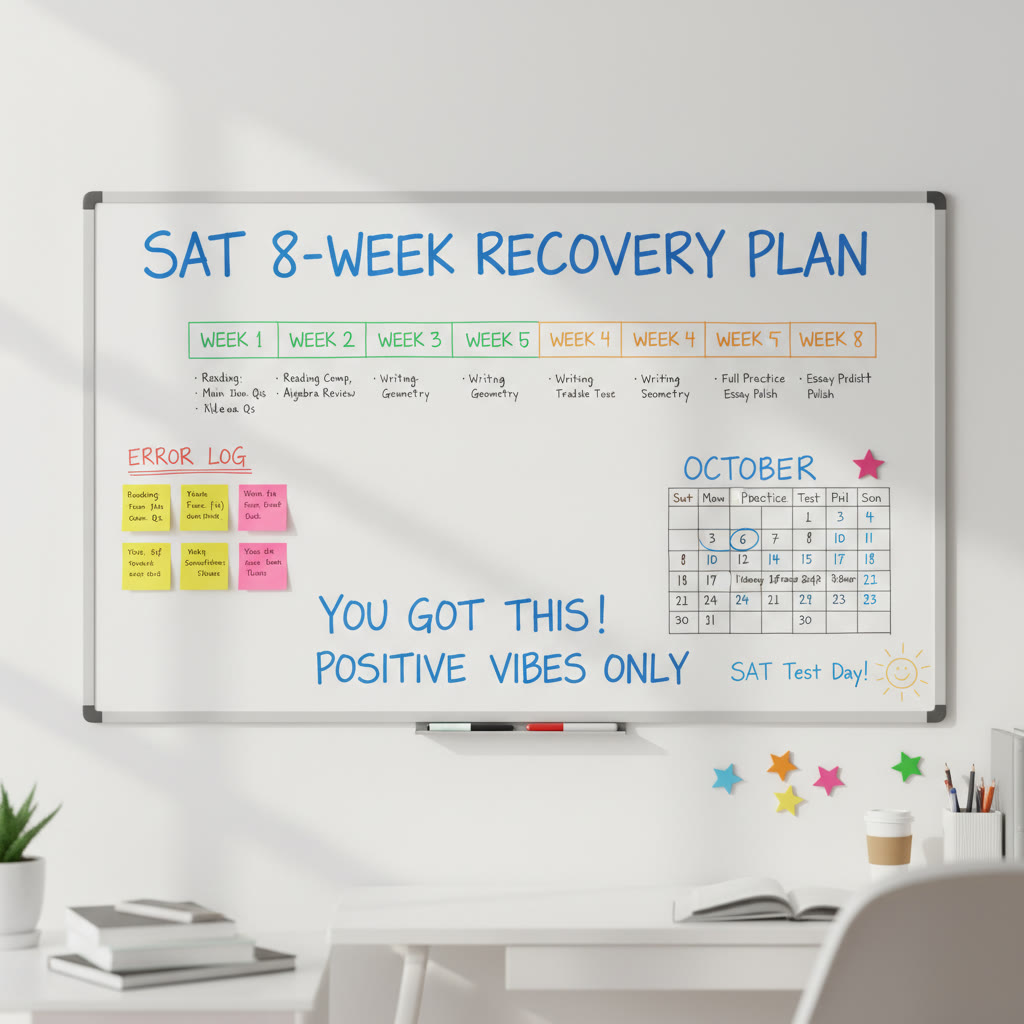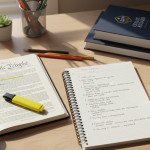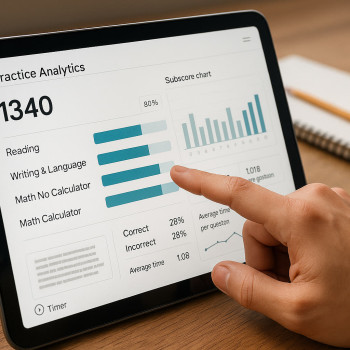When a Practice Score Feels Like a Punch in the Gut
We’ve all been there: you sit down after a practice SAT, click open the results, and your chest drops. Time seems to slow. Your brain throws up images of disappointment—parents’ faces, deadlines, college lists. That one number feels enormous and crushing. First things first: breathe. A single practice score is not the final word on your potential. It’s just data—useful, blunt, and absolutely fixable with the right mindset and steps.
Why the emotional sting is real (and normal)
Test scores tie into identity and plans. They represent months of effort and a future you’re trying to shape. When a practice score falls short, it triggers a cascade: frustration, shame, avoidance. Psychologists call this threat to the self. It’s not that you’re fragile—it’s that you care. Recognizing this early helps you respond with self-compassion instead of self-criticism.
Step 1: Emotional First Aid — Do this before you do anything else
Before you analyze errors or tweak your schedule, give yourself thirty to sixty minutes of emotional first aid. This is about calming the nervous system so you can make rational decisions.
- Step away: Close the score window. Put your test booklet away. Don’t dwell for hours.
- Breathe and reframe: Try four-square breathing (inhale 4, hold 4, exhale 4, hold 4). Then say aloud: “This is one data point, not the story of my life.”
- Small kindness: Do something that resets your mood—a walk, a snack, 20 minutes of a hobby.
- Journal for 5 minutes: Write one sentence about what upset you and one sentence about one small next step.
Emotional clarity makes effective action possible. If you jump straight into obsessing about every wrong answer while your heart is racing, you’ll feel worse and make poor choices.
Step 2: Interpret the Score — Treat it like honest feedback
Once you’re calm, put on your detective hat. A score is a map of where to invest time, not a verdict. The SAT has two main sections—Evidence-Based Reading and Writing (EBRW) and Math—each scored from 200 to 800, for a total range of 400–1600. But beyond the total, the most valuable information is where mistakes concentrated.
How to analyze efficiently
- Break results down by section (EBRW vs. Math) and by question type (e.g., passage-based, sentence errors, algebra, geometry).
- Time pattern: Were mistakes clustered at the end of a section? That can flag timing issues rather than content gaps.
- Error type: Careless mistakes, misunderstanding question stems, content gaps, or strategy failures (like misreading a chart).
- Write a brief error log: question number, question type, why it happened, how to fix it.
Example: If many math errors come from algebraic manipulation, your focus should be targeted problem-solving practice. If reading errors are concentrated in vocabulary-in-context questions, your reading approach and annotation strategy may need a tune-up.
Step 3: Reframe with realistic goals
Once you’ve diagnosed weak spots, set a attainable timeline. Avoid the trap of lofty overnight miracles. Improvements on the SAT are incremental—sustained, focused practice compounds. For many students, aiming for a steady gain (e.g., 20–50 points per month) is realistic, but your exact pace depends on current skill level and study intensity.
Sample target-setting approach
- Short-term (2–4 weeks): Fix timing and review the top 10 most common errors.
- Mid-term (1–3 months): Rebuild weaker content areas and practice full sections under timed conditions.
- Long-term (3+ months): Simulate test day several times and refine endurance and strategy.
Step 4: Create a targeted plan — Work smarter, not just harder
Once emotion is stabilized and goals are set, a clear plan is the bridge to improvement. Tailor your approach: focused drills beat random practice. Prioritize high-leverage activities—those that reduce the most errors quickly.
High-leverage practices
- 错题本 (error log): Revisit mistakes until you can explain them clearly and correct them without hints.
- Timed section drills: Short, intense practice on specific question types under clock pressure.
- Active review: Don’t just re-read explanations—re-solve questions without looking.
- Vocabulary in context and annotation practice for reading passages.
- Math fluency drills: algebraic manipulation, word-problem translation, and calculator vs. no-calculator strategy.
Sample 8-week recovery plan
Below is a sample plan you can adapt. It assumes roughly 6–8 hours per week of focused study and two full practice tests during the period.
| Week | Focus | Weekly Hours | Goal |
|---|---|---|---|
| 1 | Error log creation + timed section drills | 6 | Identify top 3 error types and reduce careless mistakes |
| 2 | Targeted content review (e.g., algebra, grammar rules) | 7 | Build conceptual clarity on weak topics |
| 3 | Timed full sections + practice reading strategies | 8 | Improve pacing and passage annotation |
| 4 | Mixed problem sets + error review | 6 | Strengthen transfer skills across topics |
| 5 | Full practice test (timed) + debrief | 8 | Measure progress and adjust plan |
| 6 | Weakest-topic intensives + test strategy | 7 | Deepen mastery of persistent weak areas |
| 7 | Mixed practice + timed sections | 7 | Enhance stamina and pacing |
| 8 | Final full test + mental prep | 8 | Enter test week confident and calm |
How to use the table
Adjust hours based on your availability. The key is consistency—small, daily practice beats infrequent marathon sessions. Schedule the full practice tests at the beginning and end to measure improvement and adjust strategy.
Step 5: Practical tactics that fix common problems
Here are evidence-based tactics that many students find transform small weaknesses into reliable strengths.
For careless mistakes
- Read the question aloud in your head or underline key constraints (e.g., “except,” “not”).
- Double-check simple arithmetic or units when time allows.
- Adopt a quick checklist for plugs: answer fits units, is within reasonable bounds, and matches question wording.
For timing issues
- Practice sections strictly timed and track pace per question (seconds per question).
- Learn to triage: skip a question after a set time (e.g., 60–90 seconds) and return if time permits.
For content gaps
- Create micro-lessons: 30–45 minute focused sessions on one concept (e.g., quadratic formulas or comma usage) and follow with practice problems.
- Use worked example pairs: study a solved problem, then immediately solve a near-identical one.
Real-world analogy: Training like an athlete
An athlete doesn’t panic after one poor meet. They review video, isolate weaknesses, tweak technique, and train. Your SAT recovery works the same way. Focus on drills for weak areas, simulate competition conditions, and build endurance. Over time, your scores are like race times—improvements come from consistent, purposeful practice.
When to ask for help—and how Sparkl can fit in
There’s no shame in getting support. If your score plateaued, your error patterns are confusing, or you’re simply stressed out and can’t focus, consider 1-on-1 guidance. Personalized tutoring can speed insights, keep you accountable, and provide strategies tailored to how you learn.
Sparkl’s personalized tutoring offers benefits that naturally fit this recovery process: expert tutors who pinpoint your weak spots, tailored study plans that match your timeline, and AI-driven insights that surface patterns you might miss. The combination of human coaching and data-driven feedback can make your practice time more efficient and keep you emotionally supported through the ups and downs.
Emotional strategies to stay resilient
Emotional resilience isn’t about ignoring disappointment—it’s about acknowledging it, then acting. Here are techniques students use to stay steady during preparation.
Mindset shifts
- View setbacks as experiments: each practice test tells you what to try next, not who you are.
- Adopt a “process over product” attitude: praise focused effort, practice quality, and strategy testing rather than raw scores alone.
Stress-reduction habits
- Sleep consistency: Aim for 7–9 hours. Poor sleep reduces cognitive sharpness and increases careless errors.
- Movement: Short exercise sessions (20–30 minutes) boost mood and focus.
- Micro-breaks: Use the Pomodoro method (25/5) to maintain energy and prevent burnout.
Concrete example: Mia’s comeback
Mia scored 1040 on a practice SAT and was devastated—she’d hoped for 1200. After a day of emotional first aid, she analyzed her test and found patterns: most mistakes were in reading comprehension and algebraic setup errors in math. Her plan over eight weeks included:
- Three weekly focused sessions: two on algebra set-up and one on reading strategies.
- A detailed error log that tracked every incorrect question and the fix she used.
- Two timed practice tests (week 1 and week 8) to benchmark progress.
She also worked with a Sparkl tutor for four sessions to refine her reading annotation technique and to get weekly accountability. By week 8 she improved to 1180—an 140-point gain—because she made small, measurable changes every week and kept her emotional energy steady.
When results don’t improve quickly: troubleshooting
If your scores stagnate, don’t double down on the same ineffective routine. Try these diagnostics:
- Are you practicing the same question types over and over? Increase variety.
- Is your review passive? Stop re-reading explanations—start re-solving without notes.
- Have you hit burnout? Scale back and reintroduce study with shorter, quality sessions.
- Is timing the real issue? Prioritize timed sections and pacing drills.
Practical checklist to bounce back (summary)
- Step away and calm down: emotional first aid for 30–60 minutes.
- Analyze patterns, not just scores: build an error log.
- Set realistic, time-based goals (2–4 weeks, 1–3 months).
- Create targeted practice sessions focusing on high-leverage fixes.
- Simulate test conditions periodically and measure gains.
- Use support if needed: 1-on-1 tutoring, tailored plans, and tools that track progress.
Image ideas


Final pep talk
A bad practice score stings, but it’s one of the most useful things you can get: honest feedback. Treat it like a coach’s note, not a character judgment. With a calm mind, a targeted plan, and consistent practice—plus support when you need it—you’ll see steady improvement. Remember: the SAT is a test of skills you can train. Your recovery is not about bouncing back once; it’s about building habits that make you more confident and sharper every time you sit for practice or the real exam.
Be kind to yourself today. Make a small plan for tomorrow. Keep moving forward.














No Comments
Leave a comment Cancel